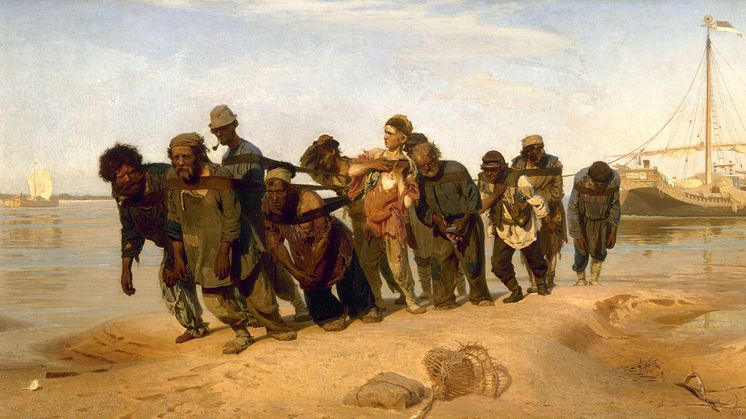
Press release -
Peredvizhniki exhibition opens 29 September at Nationalmuseum
This autumn’s major exhibition at Nationalmuseum, The Peredvizhniki – Pioneers of Russian Painting, opens on 29 September. Sweden’s first ever exhibition dedicated to this group of artists features over 100 pieces on loan from the State Tretyakov Gallery in Moscow and the State Russian Museum in St Petersburg. Works by the Peredvizhniki have long enjoyed huge popularity in Russia but remain little known abroad. Exhibition visitors now have the opportunity to discover Russian art from the era of Tolstoy and Tchaikovsky.
The Peredvizhniki were a group of artists who came together in 1870 in protest at the conservative attitudes and dominant position of Russia’s Imperial Academy of Art. Their goal was artistic freedom. Using realist techniques, group members painted nature, people and society in contemporary Russia. Poor farm labourers and political activists were portrayed with the same dedication as brooding twilight landscapes and leading intellectuals. The group used art to highlight social and political issues, organizing travelling exhibitions to take art to the people and beyond the cities of St Petersburg and Moscow. The group’s full name in Russian translates as The Society for Travelling Art Exhibitions.
The Peredvizhniki were dedicated to producing a socially engaged art, and in so doing did not avoid or shy away from controversial issues such as social injustices or tough living conditions. A typical work is Ilya Repin’s Barge-haulers on the Volga, one of the most famous Russian paintings of all time, which shows the hard conditions under which such workers toiled in fin de siècle Russia.
Some group members produced paintings containing an explicitly political message. Since freedom of expression was heavily curtailed, tackling subjects that the state might deem inappropriate was a risky business. Nevertheless, the Peredvizhniki used their art to highlight economic inequity, church hypocrisy and abuse of power, and the impotent position of the peasantry. The exhibition includes paintings featuring the political opponents of the Tsarist regime: revolutionary students and political prisoners.
In the exhibition we also encounter members of the Russian cultural elite at the turn of the century. Some of the Peredvizhniki were leading portrait painters who moved in the same circles as prominent writers, musicians and other cultural personalities. The most famous writer of the time was Leo Tolstoy, whose ideas on politics, religion and morality inspired many readers the world over. Ilya Repin’s portrait shows Tolstoy standing outside, barefoot and plainly dressed, embodying the author’s ideal of the simple, down-to-earth life.
In landscape painting, the Peredvizhniki set out to portray what was typically Russian. Images of Russia’s plains and forests came to symbolize the motherland and were influential in shaping national identity. At times, Russian landscape painting calls to mind the dreamy, melancholy landscapes painted by Scandinavian artists of the fin de siècle, so to a Swedish audience it seems familiar yet foreign. Prominent landscape painters in the group included Isaak Levitan and Ivan Shishkin.
Members of the group were also fascinated by Russia’s past, taking inspiration from folktales, myths and legends. Here too there is a parallel to the movement in 1890s Scandinavia to create a modern art based on a national cultural heritage. Common motifs included religious traditions and scenes from daily life in years gone by.
The Peredvizhniki soon became a major force in Russian art, and many of the leading painters of the time joined the group. It was 1923 when the group finally disbanded, but the exhibition focuses on the 1870–1910 period, when the Peredvizhniki had the greatest impact on the Russian art scene.
The exhibition runs from 29 September 2011 to 22 January 2012.
Theme days
Sunday 23 October and 15 January, 1-3 pm.
Exhibition catalogue
A
lavishly illustrated exhibition catalogue has been produced in Swedish
and English versions, with articles by co-curators Per Hedström
(Nationalmuseum) and Professor David Jackson (University of Leeds), and
experts from the State Tretyakov Gallery and the State Russian Museum.
Further information
Per Hedström, exhibition curator, phm@nationalmuseum.se, +46 8 5195 4356
Hanna Tottmar, press officer, htr@nationalmuseum.se, +46 8 5195 4390
Captions
Ilya Repin, They Did Not Expect Him, 1884-88, State Tretyakov Gallery; Isaak Levitan, The Vladimirka Road, 1892, State Tretyakov Gallery; Nikolai Bogdanov-Belsky, At the School Door, 1897, State Russian Museum.
Special
thanks to Anne-Marie and Herbert Lembcke for their active participation
in the exhibition project. The exhibition has been made possible by
their ideas, contacts and very generous financial contribution via the
Ad Infinitum Foundation.
Categories

